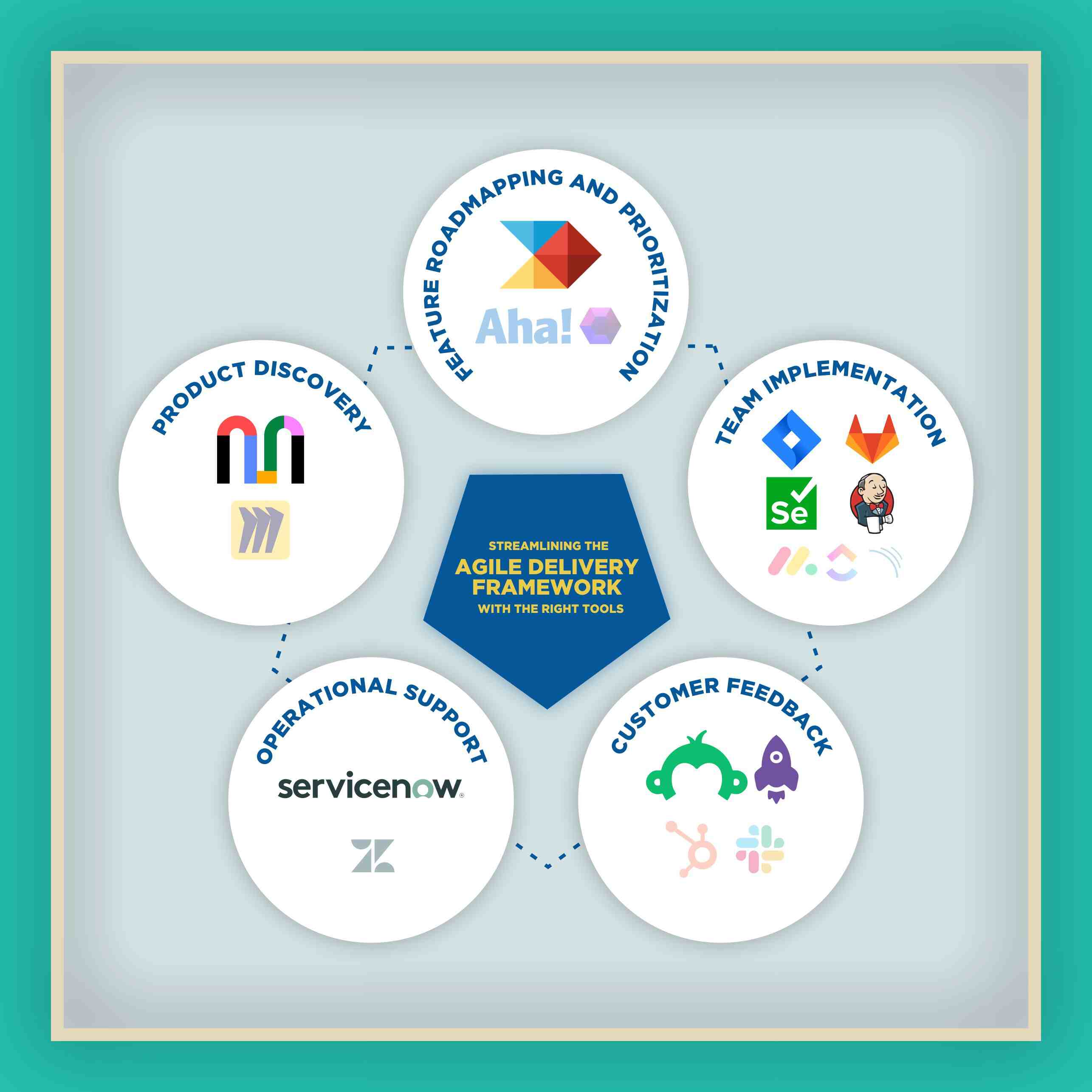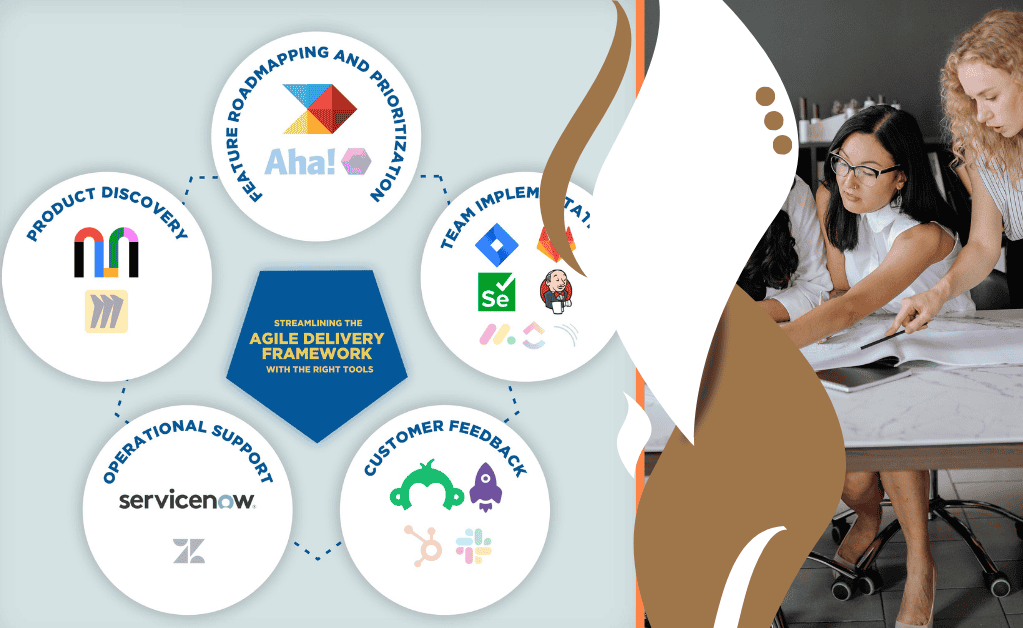Table of Contents
ToggleIn the early 2000s, the world discovered a groundbreaking approach to software development: Agile. Grounded in essential values and principles, this method aimed to bring customers closer to the teams doing the work, while empowering those teams, speeding up delivery, and encouraging early feedback—all through an iterative development and continuous improvement process. But as anyone who’s implemented agile can tell you, there’s more to it than what you find in textbooks, blogs, or YouTube tutorials. It calls for the right tools to ensure everything runs smoothly.
In this article, we’ll dive into how specific tools can enhance value delivery by exploring how different tools support the five elements of the agile delivery framework. Whether you’re a Product Manager, Scrum Master, or Software Developer, this guide is crafted especially for you. Get ready to unlock the power of Agile with the right toolkit!
Why Tools Matter
Remember the first time you tried to assemble IKEA furniture without an Allen wrench? That’s like attempting agile without the right tools. The goal here is to make life easier, not harder. From roadmaps to retrospectives, specialized tools can turn tedious tasks into streamlined workflows, freeing up your team to focus on what they do best—creating awesome products! Here are several industry-tested tools that effectively support the five elements of the agile delivery framework.
1. Product Discovery
Before you can deliver, you need to discover what’s worth delivering. Product discovery is the secret sauce that turns good ideas into great products. Fortunately, tools are available to turn your brainstorming sessions into a process for identifying business capabilities and outstanding products.
2. Feature Roadmapping and Prioritization
Not all features hold the same importance. Some are crucial for deploying Minimum Viable Products (MVPs), while others are merely “nice to have’s” or can be postponed for future implementation. The trick is knowing which is which. Product management tools should facilitate the creation and execution of product plans as the product evolves through its lifecycle.
- ProductBoard & Chisel: These tools help align your product vision with business capabilities. Incorporating AI for feature suggestion and prioritization, they can alleviate the administrative burdens on Product Managers.
- Aha!: Perfect for visualizing features and aligning them with business capabilities, Aha! gives you a single place to manage your product plans.
3. Team Implementation
Here’s where the rubber meets the road. Team implementation is the heart of Agile delivery, where ideas turn into reality. Team implementation involves the planning, execution, and delivery of high-value products to the customers when they want it. Tools that support the various aspects of team implementation must promote visibility, completion, automation, quality, and speed. Here are some products that many organizations have leveraged to support their value acceleration initiatives:
- JIRA, Monday.com, & ClickUp: Trusted by Agile teams worldwide, these tools manage everything from backlogs to sprint planning. They allow you to set up workflows, track progress in real time, and even automate repetitive tasks.
- SonarQube: Focused on code quality, this tool integrates seamlessly with your continuous integration pipelines to ensure that what’s being built meets your standards.
- Jenkins, Selenium, and GitLab CI/CD: Automation is a critical component in Agile delivery by streamlining repetitive tasks and enabling teams to focus on more strategic activities. Automation tools like Jenkins, Selenium, and GitLab CI/CD enhance productivity by automating builds, tests, and deployments. These tools ensure that software is continuously integrated and deployed, reducing the risk of errors and accelerating the release of features.
4. Customer Feedback
Once a feature is live, the customer becomes your most valuable tester. Listening to them is key to continuous improvement. By providing an easy mechanism to capture user feedback and behavior with your products, you can develop features that promote stickiness and satisfaction.
- Slack, HubSpot, SurveyMonkey, LogRocket: You can gather feedback directly from customer interactions or surveys, turning it into actionable insights.
5. Operational Support
Finally, don’t underestimate the importance of operational support. It’s the unsung hero of Agile delivery, ensuring everything runs smoothly. There is no perfect solution and products need to evolve with its customers’ changing needs. Thus, your organization must provide an avenue to collect requests or issues so that the implementation team can address them efficiently and effectively.
- ServiceNow & Zendesk: These platforms streamline issue tracking and service requests, providing a structured system for managing incoming queries and problems.
An Integrated Approach

The tools are crafted to simplify information flow and optimize workflows, boosting collaboration and efficiency. Achieving this requires integrating these tools to ensure seamless connectivity between your processes, people, and the tools your team employs. Here's an example of how an integrated system can lead to faster and higher-quality delivery.
- The product management team and customers use Mural to Prune the Product Tree and establish the Customer Journey
Leverage the ideas from Mural into ProductBoard for roadmapping and Epic prioritization.
- The Product Owner and the Agile Team breakdown the epics into user stories and manage the work in Jira
- The team seamlessly deploy quality work through an automated continuous integration and continuous deployment (CI/CD) pipeline
- SurveyMonkey to solicit customer feedback.
- LogRocket to analyze and gather user behavior and system response. Any issues are easily created in Jira without any manual encoding.
ServiceNow for work intake (e.g., requests, enhancements, issues, inquiries)
Conclusion
Although the tools discussed in this blog are not an exhaustive representation of what’s available on the market or how tools are configured, they provide a starting point that you can review and revise to support your organization’s agile delivery framework. However, remember that these are merely tools; their true value lies in how they are utilized. Therefore, choose wisely, test carefully, and continually reassess to ensure they meet your needs.
The future of agile delivery is promising, but it shines brightest for those prepared to adapt and optimize. Isn’t it time your team joined the ranks of the streamlined and successful?
